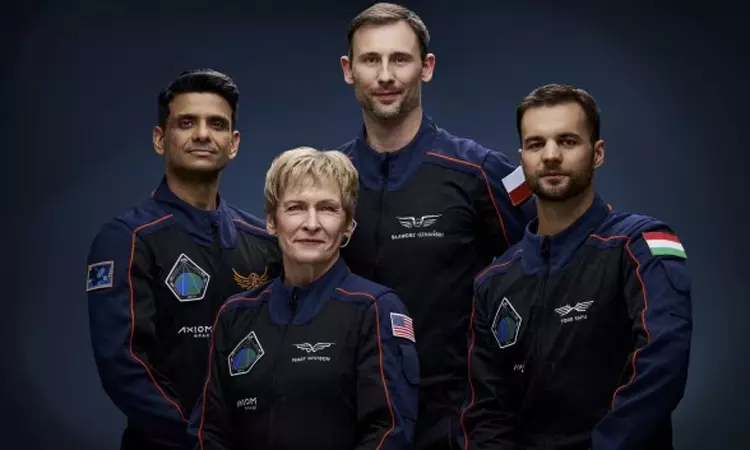On June 19, 2025, India’s pride, Group Captain Shubhanshu Shukla, is scheduled to soar into space as part of the Axiom‑4 (Ax‑4) mission to the Interna
On June 19, 2025, India’s pride, Group Captain Shubhanshu Shukla, is scheduled to soar into space as part of the Axiom‑4 (Ax‑4) mission to the International Space Station (ISS). This marks a milestone in India’s space journey—Shukla will become the first Indian astronaut aboard the ISS, following legendary Rakesh Sharma who flew in 1984 aboard a Soviet spacecraft.
Originally cleared for launch on June 11, the mission faced delays: a liquid‑oxygen (LOX) leak detected in SpaceX’s Falcon 9 first stage and a pressure anomaly in the ISS’s Russian Zvezda module. Engineers from SpaceX, NASA, Axiom Space, and ISRO joined forces to tackle the LOX leak thoroughly, conducting a full “wet dress rehearsal” and leak validation. Meanwhile, NASA and Roscosmos engineers successfully stabilized the Zvezda module’s transfer tunnel pressure, ensuring mission safety. With both challenges resolved, ISRO officially confirmed the revised launch date—June 19, 2025.
A Safe, Collaborative Effort
Safety took center stage in every decision. ISRO Chairman V. Narayanan insisted on a complete resolving of the LOX leak, a move that NDTV credited with averting potential disaster:
“The ‘leak’ has been fixed, and the ISRO has confirmed a new launch date for the mission … the back‑and‑forth between the ISRO and Axiom Space continued for several days”.
NASA referred to the clarity in Zvezda’s pressure tunnel as confirmation that the issue was “small” and typical of station operations, reinforcing confidence.
Why June 19 Matters
First Indian on the ISS – Shukla will be the first to represent India officially at the ISS, nearly 41 years after Sharma’s historic spaceflight .
Boost for Gaganyaan – This mission offers vital insights ahead of India’s own crewed launch, scheduled under the Gaganyaan programme in 2027 .
Global collaboration – Axiom‑4 unites four astronauts: Commander Peggy Whitson (USA), Shubhanshu Shukla (India), Sławosz Uznański‑Wiśniewski (Poland), and Tibor Kapu (Hungary). It’s the first time India, Poland, and Hungary will execute ISS missions aligned with national human spaceflight programmes in over four decades .
Mission Highlights & Objectives
Launch buffer: Liftoff will occur from SpaceX’s Falcon 9 at Kennedy Space Center, with a backup window June 19 and additional dates if postponed further .
Duration: The Crew Dragon spacecraft will remain docked to the ISS for ~14 days, during which the crew will conduct dozens of experiments .
Indian-led experiments: More than 60 scientific investigations are planned, including ISRO-originated projects: microalgae growth, muscle regeneration, crop resilience, human‑display interaction, and tardigrade survival in microgravity .
Nation-building: The mission is a symbolic step toward fostering domestic innovation. The specially designed Axiom‑4 badge, created by Indian designer Manish Tripathi, encapsulates India’s space legacy—from ancient astronomy to Gaganyaan dreams—signifying a proud cultural identity in orbit .
What This Means for India & the World
Inspirational symbol: Shukla’s voyage could ignite curiosity and ambition among India’s 1.4 billion citizens—especially youth—reinforcing science and STEM education.
International presence: This signals India’s arrival on the international crewed flight stage, joining the U.S., Russia, China, and emerging European partners.
Gaganyaan groundwork: Operational data and crew experience from Axiom‑4 will directly feed into Gaganyaan, India’s first homegrown crewed spacecraft.
Private-public synergy: The Ax‑4 mission, executed via Axiom Space and SpaceX but backed by ISRO and NASA, exemplifies emerging global partnerships.
The Human Side
Group Captain Shubhanshu Shukla, a decorated Indian Air Force pilot with an M.Tech in Aerospace from IISc Bangalore, underwent rigorous training in Russia and at NASA/Axiom’s Houston facilities. At 39 years old, he also represents modern India—committed, collaborative, and aspirational.
Peggy Whitson, a veteran NASA astronaut and Axiom mission commander, brings invaluable leadership. The diverse crew symbolises unity beyond borders, science over politics.
The Road Ahead
As June 19 approaches, global eyes will remain fixed on Kennedy Space Center. The mission success will echo far beyond orbit—it will ripple through classrooms, laboratories, and future mission planning.
For India, it’s a moment of cosmic pride and scientific promise. When the first rocket engine roars and the Dragon capsule arcs skyward, a nation will watch with collective breath held—because engineering marvels mean little without the human spark behind them.


COMMENTS